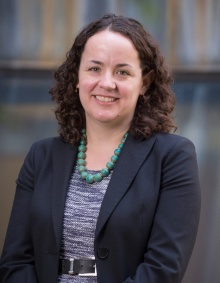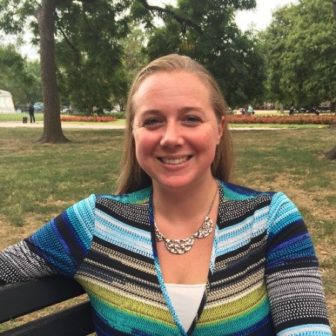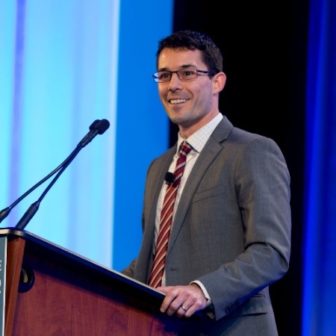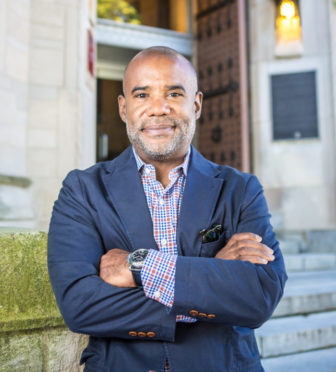The fight against youth homelessness drags on and on. It is not that the fighters are no match for a seemingly intractable issue that has haunted the nation for decades. Rather, the tangled causes of youth homelessness defy thoughtful solutions. One problem is solved, but another peril is waiting to ensnare youth.

University of Buffalo School of Social Work
Elizabeth Bowen
“It needs work across sectors, it is not just a housing issue,” said Elizabeth Bowen, an assistant professor in the School of Social Work at the University of Buffalo. “We need child welfare involved. We need educators involved. We need criminal justice involved. There is no singular pathway.
“A lot of people think it should be easier to fix in a wealthy country like this. It is a complicated problem that reflects a lot of complicated problems in our society.”
If you were to put together a plausible case study from an amalgamation of interviews with national youth homelessness experts, it would read like this:
A 17-year-old hits the streets, perhaps because his family is deep in poverty, which causes family conflict. A local agency steps in with financial support for the family, but the conflict has left scars and family reunification services are needed. In the meantime, the 17-year-old is couch surfing with friends or sleeping in a car and develops asthma, a common issue for homeless people. It goes untreated and he starts missing school his senior year. When he misses classes, he does not graduate and is thrown into a pool of untrained labor. He ends up in a shelter for adults because his $8.50 an hour job doesn’t pay enough for rent.
The 17-year-old does not leave a trail for social services workers either. The Institute for Children, Poverty and Homelessness (ICPH) estimates there are 1.3 homeless million youth in the United States and that three-quarters of them are couch surfing.
“We refer to them as the Hidden Homeless,” said Chloe Stein, a senior policy analyst for ICPH. “It is hard to identify them, and if you can’t identify them it is hard to get them the services they need.”

Chloe Stein
And even if they are identified, these couch surfers may not qualify for federal funds.
“That doubled-up population, HUD doesn’t count them as homeless,” Stein said, referring to the U.S. Department of Housing and Urban Development. “The Department of Education counts them, but they are unable to receive HUD money. If doubled-up students were included in the [HUD] homeless definition, that would make a difference. They are experiencing housing insecurity.”
How many are there?
Samantha Batko, research associate at the Urban Institute said one of the reasons the nation has struggled in its fight against youth homelessness is “defining scale,” or knowing how many people need help. The point-in-time counts — everyone inside shelters, everyone outside shelters on a given night — cannot track homeless youth accurately.
“They may not congregate at the same time, or in the same places as adults,” she said. “So for a long time local enumerations weren’t capturing unsheltered youth at the number they thought they were there. That has improved, but we are not capturing all the unsheltered youth at the same place.”
One of the reasons it is hard to get at the numbers is because youth do not feel safe in the same shelters as adults.

Samantha Batko
“There is not enough dedicated youth shelter space, and youth may not enter adult shelters out of fear and they may feel uncomfortable with older adults,” Batko said. “They may use alternative sleeping arrangements where they might have accessed dedicated youth shelters if they were available. So there is a raging policy debate about who to consider homeless.”
Homelessness affects mainstream safety nets, like foster care and child protective services.
One in four youth aging out of foster care experience homelessness, Batko said. The 2008 Fostering Connections to Success and Increasing Adoptions Act was a step forward because it helps states extend support to caregivers. California is the best example of extending care, but not all states provide the level of health care, legal aid and housing California does.
Angie Schwartz, the policy program director for the Alliance for Children’s Rights, said that when the federal government passed a bill in 2008 extending foster care, California immediately jumped on board to receive the federal money, which is essentially half the cost of care. It helped that the California Legislature is full time and got a quick start on passing the bill, but more important was the co-sponsorship of the legislation by unions, county agencies that oversee child welfare and the courts.
“Courts almost never sponsor legislation,” Schwartz said.
The Alliance for Children’s Rights was an early supporter, along with the California Youth Connection, the Judicial Council and other legal aid groups. The providers to youth in foster care were also co-sponsors.
“We got dedication from every corner of the system,” Schwarz said.

The Alliance for Children's Rights
Angie Schwartz
While the system in California works, other systems wobble.
“A lot of people think child protective services should step in with homeless youth, but there are some people who don’t want child welfare to step in because of the poor outcomes for youth who age out,” Batko said. “There is a large debate on how to handle minors.”
What belongs in the big-picture solution for youth homelessness, Batko insists, is a push for “family reunification.”
“It can be a really cost-effective use of resources. Sometimes that means helping the family financially,” she said. “And providing support for the family to stay together is beneficial for the youth. The youth can go back to family, but it can take longer. Sometimes you need crisis housing for that.”
Almost half get arrested
Bryan Samuels, the executive director of Chapin Hall, a research think tank that studies youth homelessness among other social issues at the University of Chicago, said society is missing opportunities to eradicate youth homelessness. Those chances come from laying so much at the feet of homeless youth.
“People assume the problem is with the youth themselves, and if we just fix the youth we fix the problem,” he said. “Our intervention has to be wider in its consideration.
“Go look at the Runaway and Homeless Youth Act. There is something described under the header of ‘Findings.’ When you look at those findings, almost all of those findings are about the youth. There is no mention or reference to the family. If findings are oriented toward the youth and policies toward addressing the youth, then you end up with a blind spot in understanding that the nature of the problem is with the families.”
The youth homeless crisis intersects with the justice system in a big way. According to Chapin Hall research, 46 percent of youth experiencing homelessness have been in juvenile detention, prison or jail.
“That is pretty startling, even higher than we anticipated,” said Matthew Morton, a research fellow at Chapin Hall, who leads the work on youth homelessness. “Because they are trying to survive on the streets they are more likely to come into contact with law enforcement.

Matthew Morton
“It can be a young person contacted for lifestyle crimes, or arrested for condition of homelessness, or having to use certain facilities at certain times of the day,” he said. “There could be survival methods on the street and that might involve stealing, that might involve self-medication.”
A disproportionate number of homeless youth who find themselves tangled up in the justice system are minorities, either black, Hispanic or Native American, Morton said.
Too many silos, no centralization
One significant problem is that social service organizations that act as caretakers for homeless youth seldom talk to someone from the criminal justice system, he said.
“When I go into communities on coordinated responses around youth homelessness I share that statistic and often the folks involved in homelessness services will look around and realize they don’t have somebody from the criminal justice system sitting at the table,” Morton said.
Another central question is whether there are too many Band-Aids and not a significant national push.
“The biggest challenge is how to get providers, case managers, cities, mayors, government officials and philanthropists to come together and get youth a higher bar as far as solutions,” said Larry Cohen, the executive director and co-founder of Point Source Youth, a national nonprofit organization. “Get them their own apartment, their own lease, a social worker to help them out. We need to think like that.”

Chapin Hall
Bryan Samuels
One in 10 youth experience unstable housing in a given year, Cohen said.
Samuels said the issue is sufficiently national and cross-cutting that perhaps it needs centralized leadership in Washington, D.C., not a wide collection of programs.
“Nobody has a single eye on the problem and nobody is singularly responsible for addressing the problem,” he said. “It pops up in schools, in mental health issues, child welfare. These problems come into fruition in a lot of public entities.
“This is not an indictment of the effort and intent of people to solve the problem. But there is no homeless system, there are only programs and those programs are only as good as the limitation of money and practice allow them to overcome.”
The positive news is that “There is a lot more awareness about youth and family homelessness,” said Bowen of the University of Buffalo. “That in itself is an important development. Ten years ago not as many people were talking about it and not as many researchers were looking at it and not as many policymakers were paying attention to youth homelessness. At least there is more attention on it.”
They are ‘amazing people’
Cohen feels the issue does not need to be as complicated as we make it.
“Meeting people where they’re at is important and supporting youth through the process and giving them what they need is paramount,” he said. “What they need may be different than what the provider needs from them.
“Giving them what they need and what they ask for is a barrier we need to keep focusing on.”
It is an emotional issue for Cohen and others who have seen up close the beat-down that comes from couch-surfing and begging for help.
“Celebrate young people,” he said. “These are great people and it is our job as a society to help them. They are experts in their own lives. Instead of putting things on them, ask them what would help them most.”
Cohen wants his plea to break through barriers erected by greed and apathy. Solving youth homelessness is not just a policy issue, it is an individual issue. To that end, Point Source Youth has created a host homes program in which vetted community members open their homes to youth for a few months at a time. That benevolence is a bridge from the street to permanent housing.
“Too many people are not open-hearted, they are not open-minded, they are biased, and that has to change,” he said. “We have to treat these youth as the amazing people they are.”
Editor’s note: This article, part of a series on homelessness and its intersection with youth justice, is made possible in part by support from the Park, Raikes and Tow foundations. Throughout this project, Youth Today will maintain editorial independence.
Many good points in this article . Cleatly, youh homelessness is not just about housing (or poverty). Designated services for homeless youth are scarce. Rest assured though, family counseling and reunification are core services of federally funded RHY programs as is coordination with varous providersand sytems inc the jusice system. RHY programs offer an effective service model with individualized service plans tailored to the needs of each youth and family. Such programs are woefully underfunded.